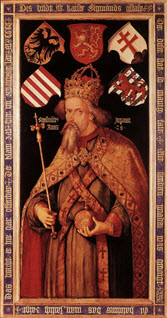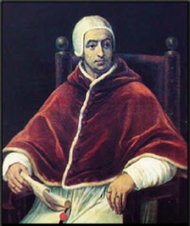


THE COUNCIL OF CONSTANCE 1414 -
xxxxxThe Council of Constance
was called in 1414 to make yet another attempt to solve the Great
Schism which had divided the Church since 1378
(R2). By 1409 there were three popes in
existence, at Rome, Avignon and Pisa. Under the guidance of
Sigismund, king of Germany, it issued the Sacrosancta,
giving the council supreme authority. The popes at Avignon and Pisa
were then deposed and the one at Rome ordered to abdicate. This
achieved, in 1417
Martin V was elected as the only rightful
pope and the “schism” was brought to an end. But the damage done to
papal authority was far from over. From now on there were to be
regular council meetings to regulate the Church -
xxxxxAs we have seen, on the return of the pope to Rome in
1377 following the “Babylonian Captivity” in southern France, the papacy became
tragically split -

xxxxxIt was against this background that the Council of Constance met in 1414, mainly due to the insistence of Sigismund I, King of Germany. After introducing a new system of voting, it then issued the decree Sacrosancta. This stated that the authority of a general council of the Church was superior to that of the pope, and that, in the future, councils were to be held frequently in order to ensure the proper government of the Roman Catholic Church. The pope at Pisa, now the antipope John XXIII, having fled from Constance in the hope of breaking up the meeting, was then deposed, together with the pope at Avignon, Benedict XIII, whilst the pope at Rome, Gregory XII, was ordered to abdicate, which he did under protest. This achieved, in 1417 the Council elected Martin V as the one and only rightful Pope. The Great Schism which had begun in 1378 was over. (This portrait of Sigismund is by the German artist Albrecht Durer.)
xxxxxBut the
damage done by the Great Schism was certainly not over. Quite
apart from the loss of authority and prestige suffered by the
papacy during this unholy split -
xxxxxBut the Council of Constance was not wholly concerned with ending the Great Schism. Among other matters, it condemned the teaching of the English priest John Wycliffe, founder of the Lollards, and, as we have seen, denounced the Bohemian religious reformer Jan Hus as an obstinate heretic. He was handed over to the secular authorities and burnt at the stake in 1415.
 xxxxxIncidentally, Benedict XIII (illustrated), the former pope
at Avignon, refused to accept the Council’s ruling. From his castle
at Peniscola he maintained for the rest of his days that he was the
rightful pope. Referred to as the Pretender Pope, he was creating
new cardinals as late as November 1422. Then, on his death, one of
his cardinals, Jean Carrier, elected a Bernard Garnier as Benedict
XIV! He ended his reign in 1430. As no one except Carrier knew where
he lived, he became known as the “hidden pope”. In the meantime,
King Alfonso V of Aragon had his own pope elected as Clement VIII,
and he reigned until his abdication in 1429!
xxxxxIncidentally, Benedict XIII (illustrated), the former pope
at Avignon, refused to accept the Council’s ruling. From his castle
at Peniscola he maintained for the rest of his days that he was the
rightful pope. Referred to as the Pretender Pope, he was creating
new cardinals as late as November 1422. Then, on his death, one of
his cardinals, Jean Carrier, elected a Bernard Garnier as Benedict
XIV! He ended his reign in 1430. As no one except Carrier knew where
he lived, he became known as the “hidden pope”. In the meantime,
King Alfonso V of Aragon had his own pope elected as Clement VIII,
and he reigned until his abdication in 1429!



Acknowledgements
Sigismund: by
the German painter Albrecht Durer (1471-
H5-